18 Mass Sonority
Mass Sonority
Traditionally, the composer’s implementation of symphonic ensembles consisted of building large sonorities from smaller instrumental groups in a hierarchy of functions. In effect, it was used as a timbral palette wherein various forces were engaged to provide a means of transparency for the arrangement of polyphonic, motivic, textural, or harmonic ideas. As such, the modern orchestra sought for a balance between the wind, brass, percussion, and string groups to permit the composer the greatest flexibility while maintaining acoustical equilibrium. This was accomplished through quantity of personnel, such as the need for twelve to sixteen first violins while there might be only three or four flutes, two or three trumpets, and so forth. Experimentation throughout Europe led to the development of the standard orchestra in its modern form by the late 19th century.
Despite the fact that the musical materials of the first half of the 20th century might have been quite different than those of the preceding era, the utilization of the standard symphony orchestra remained firmly grounded in the concepts of the Common Practice. This may be due to the fact that many of those composers were first educated on model works of the 18th and 19th centuries, and that they often wrote their first pieces in an idiom directly influenced by the concepts that governed these stylistic premises. Even as their distinctly unique styles emerged to challenge many of the fundamental principles of the Western musical canon, their approach to orchestration, however original and personal, remained well within the confines of the tradition they inherited.
However, in the post-World War II era, a number of composers (working independently of one another) began to write works in which the instrumentalists of a large ensemble would participate in building sonorities in a fundamentally new manner. These mavericks, mostly of Eastern European origin, such as Iannis Xenakis (1922-2001), György Ligeti (b. 1923), and Krzysztof Penderecki (b. 1933), began by dividing the orchestra into a collection of individuals, each with their own (albeit inter-related) part: if there were sixteen first violins, there would often be sixteen unique parts, if four clarinets, four parts. Rather than supporting musical arguments based on motivic manipulations, melodic contours, or harmonic progressions, the materials these composers began using for dramatic development arose directly from the changing textures, timbres, and dynamics inherent in the body of instruments at hand alone. Although, of course, other types of content could punctuate the texture, the primary concern was based on the accumulation of sounds, hence the term mass sonorities.
In our bagatelle below, we will explore various techniques involving composition with mass sonorities. Although many of the composers that initially dealt with mass sonorities first wrote for either orchestra or string orchestra, for the purposes of this lesson, we will create a selective large ensemble comprised of three oboes, three clarinets, four French horns, three violins, three violas, and three violoncelli, and tympani (C score).
‘Sculpting’ a Texture. One method developed to work with mass sonorities involves composing similar, yet different, lines for instruments of the same timbre. These lines are then shaped (not unlike sculpting) to present an overall contour. However, the ability for the listener to hear each part is suppressed through persistently erratic rhythmic patterns and the close interweaving of the individual lines. In our example, we have written irregularly rising pizzicati lines in the celli until they reach a cluster, wherein a uniform rhythm is established.
Listen: Track 40
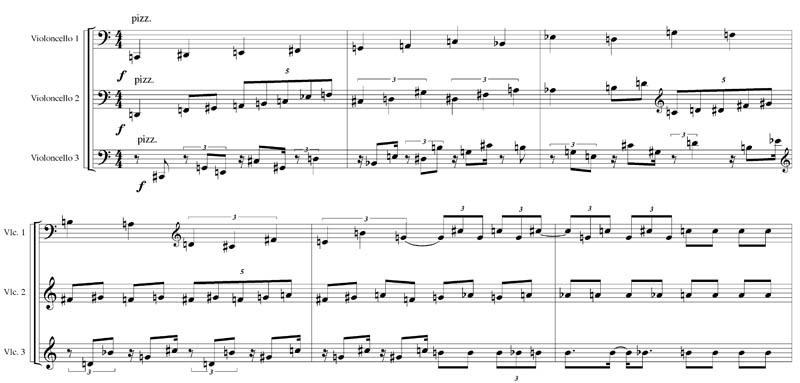
Developing a Texture. Even though the materials used in mass sonority may substantially differ from most traditional concepts concerning compositional organization, it does not mean that this precludes some of the fundamental ways of transforming musical ideas. For instance, we can use the violoncelli parts above and invert their linear contour while maintaining their rhythmic design.
Listen: Track 41
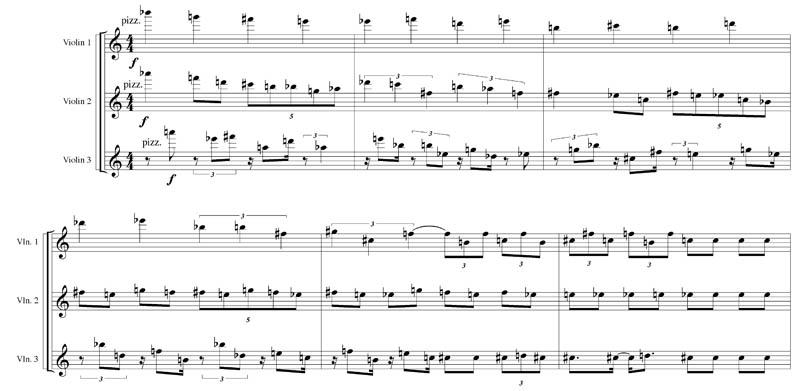
Weaving Textures Together. Now that we have two closely related textural ideas, we can begin to shape how they will interact with one another. We have chosen to beginwith the violin pizzicato passages and juxtapose the cello lines after two bars (almost like an inversion canon!). When these two forces come close together in terms of register, the violins arch briefly before they come into complete rhythmic unison only to be followed by a bar of rhythmic flux on this ‘cadential’ cluster of pitches.
Listen: Track 42
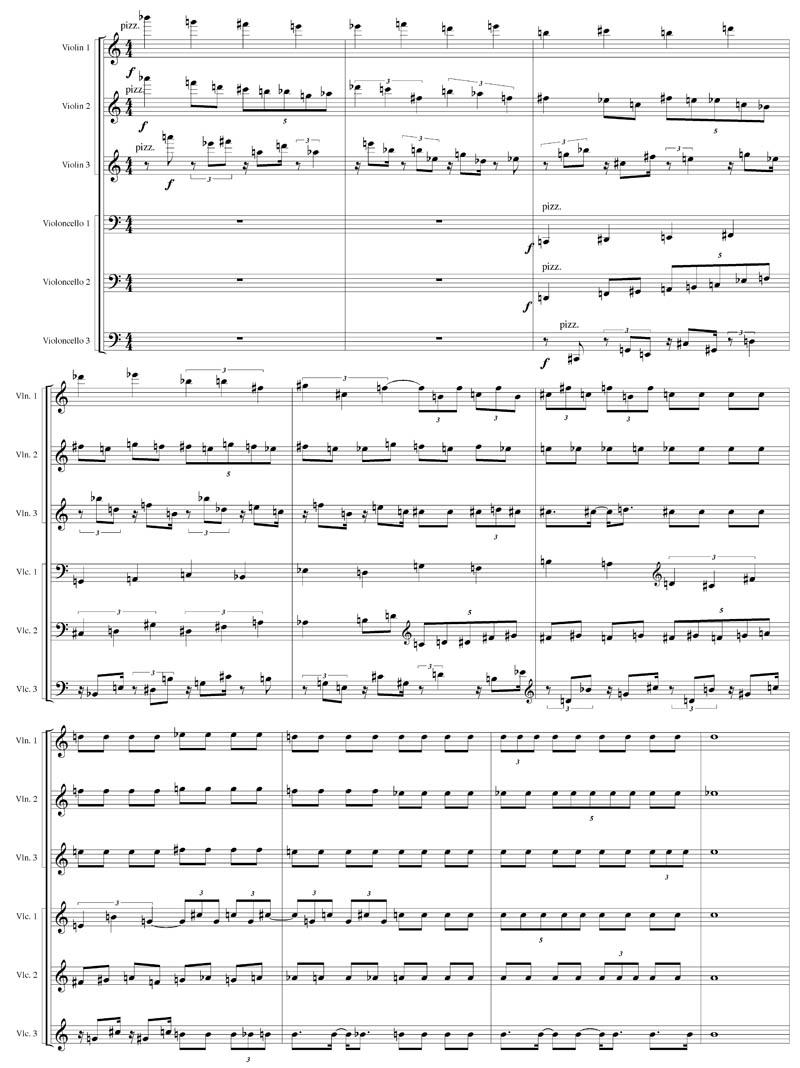
Creating a Contrasting Texture. Almost in the same sense as with first and second themes in a sonata form, contrasting textures are used in mass sonority composition to produce dynamic dramatic interplay. To build such a condition in our piece, we will write a fragment for the winds. Consisting of overlapping static dyads (orchestrated as oboe/clarinet pairings), a more ‘lyrical’ musical idea is brought into play against the erratic strings.
Listen: Track 43
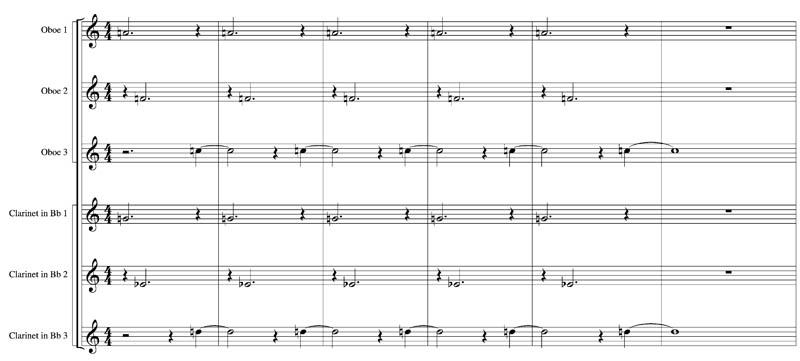
Other Textural Ideas. Interjecting other types of material into the overall texture can include those of a percussive nature (whether or not involving percussion). In our piece, we have combined the brass and tympani to provide such a function. Similarly to how we implemented the concept of inversion between the violins and violoncelli, the transformation technique of retrograde is applied to the brass parts. The resulting symmetrical patterns present anchors for the listener in comprehending the temporal organization of the sound masses. The harmonic content of these French horn parts is clustered, reflecting the same nature of the winds.
Listen: Track 44
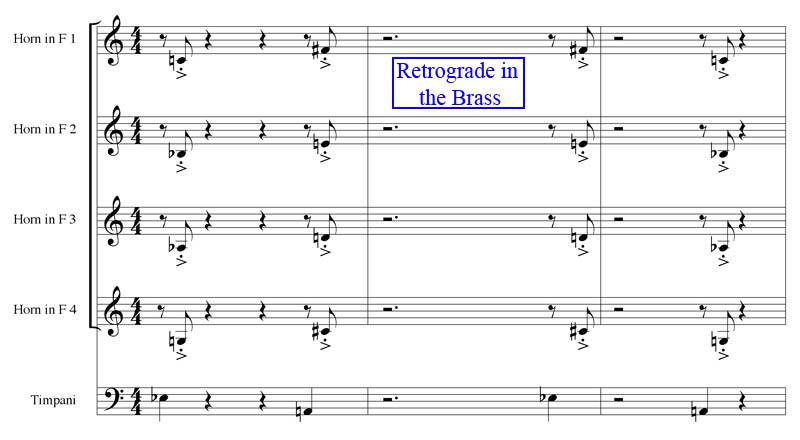
Arranging the Forces into an Overall Musical Texture. At this point, we are ready to organize the various separately composed parts into a cohesive whole that should contain both dramatic content and a logical progression/juxtaposition of the internal sub-textures. At the close of the fragment, we have added a freely composed, somewhat capricious, segment to allow for closure to the musical idea.
Listen: Track 45

